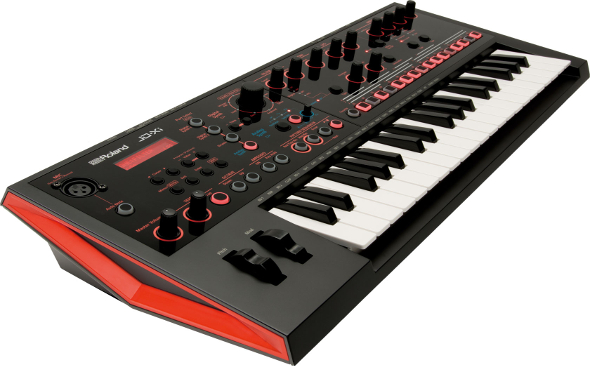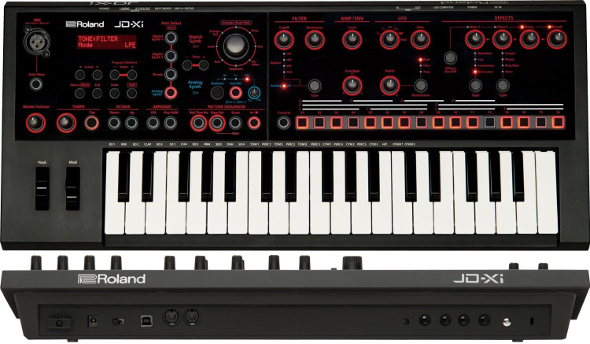Roland – JD-Xi

Marco Rodrigues feels his way around the simplicity of Roland’s JD-Xi analogue to digital crossover synthesizer.
As I entered Juno’s show room to get my hands on Roland’s new JD-Xi for this review I was met by the sound of excitable staff members inquisitively twisting the synth’s cut off on a fast and circular arpeggio. My first impression was it sounded a little flat for my liking and I was initially worried the JD-Xi might fall a bit short on the company’s promise of being a powerful but affordable ‘crossover’ synth between digital and analogue synthesis. When I took over selecting sounds from the wide range available on Roland’s newest product it soon came clear this machine is more of a complex beast than I first realised.
By managing to condense a wide range of tools used in dance music composition into the one box – diverse synth patches, pads, drums, effects and vocoder are all available – the JD-Xi proves to be tailor-made for losing yourself in creativity. It’s essentially a workstation offering users quick functionality to knock out great-sounding elements and sequenced patterns, fast. And while there’s room for manipulation, the front panel is almost too simple; for the most part it prompts users to choose a sequence, and combine and program, rather aiding intuitive delves into synthesis.
The fact that everything’s so simplified means a lot of the nitty gritty aspects of creating your own sounds from scratch lay to be found in digital menus, accessible through a small LCD display. Even when you do dive head-first into customisation to find that perfect delay time or reverb size, for example, there’s a general sense of limitation, the kind you don’t want. Why commit to just one reverb size in your production? A lot of the most interesting uses of space in modern electronic music come from the ability to change parameters drastically in real time, and in more ways than just dry or wet.

It would be unfair to judge the Roland JD-Xi against the possibilities of a DAW or other synths, drum-machines and effects units that are designed with specific functionality of parameters in mind. The JD-Xi’s small, black and red plastic shell does, very generously, hold many features. The various digital synth voices, several drum racks, analogue signal paths, filter, step sequencer and effects were more than enough to have me happily, and creatively, jamming.
The basic mechanism for writing tracks in the JD-Xi is fairly simple. There are four possible layers of parts; two of them allocated for digital synths, one for drums and the fourth for what seems to be a separate signal path with its own analogue signal filter. The two digital synth layers offer a wide range of polyphonic and monophonic sounds, ranging from ethereal pads, various basslines, strings, and stabs, while the analogue path is predictably limited to the usual square, saw and triangle waves, with added sub and pulse-width modulation. Every pattern can be recorded from the keyboard into a quantized sequence, or step-sequenced into each of the four layers.
All the sound controls on the panel – filter, amp, effect amounts, and others – are assigned to each of the four individual layers. In the case of drums, exaggerating the filter’s resonance for each percussive sound allowed me to program some crazy patterns with really unexpected tonal qualities not completely unlike some of Jeff Mills’ trippier compositions. The JD-Xi’s panel knobs and functions also allow you to record parameter variations into each pattern, bringing another important layer of elasticity to the creation of sound, and ultimately, music.

I pleasantly stumbled into a whole new realm of creative possibility purely derived by my own voice using the JD-Xi’s vocoder. Signal captured by the microphone could be used to trigger sounds, and through the use of the Auto Note feature there are options to help determine pitch and intensity. As a result fortuitous and imperfect artefacts would interact with the patterns in the step-sequencer, generating really interesting, modulated results. By rhythmically tapping on the microphone arm instead of using my voice I found even more interesting interplay and timbre variation.
Within a few hours of using the JD-Xi I had managed to program and complete several tracks. From here there are options to sync these sounds to an external MIDI clock, over dub new, live arrangements, play around and record with vocoder artefacts, add strings, sound effects and create complex tonal compositions with percussive sounds. I was left thinking that with the right amount of homework – programming and customisation – this machine could be a formidable tool for the live context – even if isn’t necessarily for improvisation or experimentation.
The JD-Xi is a great entry-level piece of gear for producers that wish to venture into hardware, while still moving away from the sometimes paralyzing ‘infinite’ possibilities of DAW-based music production, without spending a fortune on a number of specialised machines.
More info/buy
Marco Rodrigues